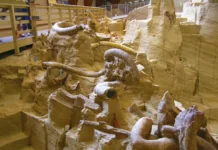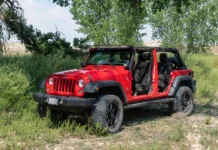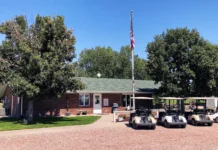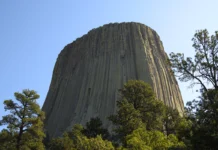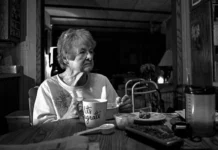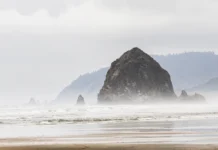| NEBRASKA |
Fort Robinson is a significant feature of Fort Robinson State Park, comprising more than 22,000 acres of Old West history, lodging, camping, Pine Ridge scenery, and the park’s bison and longhorn cattle herds. It has been named one of the nation’s top family reunion spots by publications, including USA Today.
Beyond the horse-drawn tours of the park and hayrack breakfast rides, Fort Robinson hides a dark and often bloody history. Not only has it been used as a beef research station and a K-9 dog training center in its nearly 150 years of existence, but the historic landmark was also once the home of the world’s largest quartermaster remount depot, supplying many of the over 1 million horses and mules sent overseas from the United States to Allied troops in World War I, of which only 200 survived to return to America. The fort was also used as a German prisoner-of-war camp in World War II.
Possibly the most controversial parts of its history, however, are the fort’s roles in the death of famed Sioux war chief Crazy Horse on September 05, 1877, the Cheyenne Breakout or Northern Cheyenne Exodus, and the Fort Robinson Massacre, which both occurred in the winter of 1888-1889.
| THE DEATH OF CRAZY HORSE
Crazy Horse, nicknamed Curly by his mother for his brown, curly hair, which resembled her own, was born between 1840 and 1842 in the Black Hills of South Dakota, near present-day Rapid City. His father, also named Crazy Horse, was a member of the Oglala Lakota and a shaman. His mother, Rattling Blanket Woman, was a sister of the famed Brule chief Spotted Tail.
Rattling Blanket Woman died at around 30, hanging herself after her husband returned from defending a neighboring Lakota village with three new, much younger wives in tow. After her death, the elder Crazy Horse took Rattling Blanket Woman’s sister, Good Looking Woman, as a replacement wife. She stayed to raise Curly, who was only about 4 years old at the time of his mother’s death.
When Crazy Horse was about 14, he went on a vision quest after witnessing the death of Chief Conquering Bear during the Grattan Massacre near Fort Laramie, Wyoming. After fasting for at least two days, a warrior mounted on horseback rode out of a lake before him. The warrior told Crazy Horse that he would never be harmed in battle if he dressed modestly, took no scalps or trophies in battle, and did not allow his fellow tribesmen to touch him.
Crazy Horse followed these instructions, and the only injuries that he received were when an arrow struck him after taking the scalps of two enemies in battle when he was shot in the face by a warrior named No Water after eloping with the man’s wife and the night that he died, stabbed in the kidneys with a bayonet while being forced into the guardhouse at Fort Robinson as a fellow warrior, possibly his friend Little Big Man, held him by the arms from behind.
| THE CHEYENNE BREAKOUT
In August of 1873, the Red Cloud Agency was moved from its original location, one mile west of present-day Henry, Nebraska, to a hill overlooking the White River, near what is now Crawford, Nebraska. The following March, after the shooting death of Indian Agent Frank Appleton at the hands of a hostile Lakota warrior, a military camp was established at the agency site. It was named Camp Robinson in honor of Lt. Levi H. Robinson, who native warriors had killed in February of 1874. In May of 1874, the camp was moved 1.5 miles west of the agency to its current location and renamed Fort Robinson in January 1878.
Fort Robinson played a major role in the Sioux Wars, beginning with the Battle of Warbonnet Creek in 1876 and continuing through 1890. In April of 1877, one thousand Sioux tribal members led by Touch The Clouds surrendered at Spotted Tail Agency in South Dakota, and Dull Knife (also known as Morning Star) brought his band of Northern Cheyenne to Fort Robinson. The final total of natives who had surrendered at these camps numbered nearly 4500 people.
In August of 1877, Dull Knife and the Northern Cheyenne, who had surrendered with him at Fort Robinson, were taken to Darlington Agency, located in Indian Territory in present-day Oklahoma. During the following year, they suffered terribly from malnutrition and disease, and many died. Despite their misery and hardships, their pleas were repeatedly denied when they requested to return home. Of the over 950 Cheyenne who had arrived in Indian Territory, fewer than 350 remained alive by September of 1878, when the Northern Cheyenne took matters into their own hands. Led by Dull Knife and Little Wolf, they began an epic journey back to their ancestral homeland.
The Northern Cheyenne planned to seek refuge at the Red Cloud Agency, not realizing it had been relocated again to South Dakota. Leaving their tepees standing, Dull Knife, Little Wolf, Wild Hog, Old Crow, and the remaining 300 Cheyenne women, children, and warriors slipped past the guards and fled Darlington Agency at 10 pm on September 7th, 1878, one year and two days after the death of Crazy Horse.
In 44 days, Dull Knife, Wild Hog, Little Wolf, and Old Crow would lead their desperate, starving followers over 750 miles across Oklahoma, Kansas, and Nebraska, with thousands of cavalry and artillery troops in hot pursuit. Dull Knife and Little Wolf split their ranks, with soldiers closing in on all sides. Little Wolf and his followers headed for the Powder River, eluding capture and eventually reaching the relative safety of Montana. The remaining Northern Cheyennes turned toward the Red Cloud Agency, mistakenly believing they could find sanctuary with Red Cloud and his band of Lakotas.
On the foggy morning of October 25th, 1878, troops from the Third Cavalry, based at Fort Robinson, stumbled across Dull Knife and Wild Hog’s camp. The natives were taken into custody and herded into an empty wooden barracks at Fort Robinson.
| THE FORT ROBINSON MASSACRE
In the early days of their incarceration in the Fort Robinson guardhouse, the Cheyenne were treated relatively well. The women and children were allowed free movement in and out of the barracks, while the men were allowed outside of the building while under guard.
The situation deteriorated rapidly when orders once again came to return the Northern Cheyenne to Indian Territory. When negotiations with the tribal leaders broke down, Captain Henry W. Wessells ordered Wild Hog and Old Crow removed from the barracks and cut off food, water, and firewood to those left in the guardhouse.
Believing that they had been left to starve and freeze to death, on January 9th, 1879, the remaining Northern Cheyenne opened fire on the guards in their prison, using weapons they had hidden when they were imprisoned the previous October. Many fell and died between the parade ground and the river, but others managed to climb the hills behind the post, scrambling for their lives in 10F weather. Of the 149 Cheyenne, sixty-four were killed, twenty were wounded while attempting to escape, and many of the rest made it to the Pine Ridge Reservation in South Dakota. Eleven soldiers were killed, and ten were wounded.
The guardhouse where the Cheyenne were held in the winter of 1878 and 1879 has been recreated and can be visited, along with the marker commemorating the location of Crazy Horse’s death, at Fort Robinson.
To retrace the route of the Northern Cheyennes’ flight across Nebraska, take U.S. 6 west from McCook to Imperial, then turn north on Nebraska Highway 61. Follow it through Ogallala and into the Sandhills. Turn west at Hyannis on Nebraska Highway 2 to Alliance. Travel north on U.S. 385 to Chadron and west on U.S. 20 to Crawford and Fort Robinson.
| EPILOGUE
There’s much more to the history and brutality of the Cheyenne Breakout, but we’d have to write a book to cover it all, so we’re encouraging you to learn more about the Indian Wars and the history of Fort Robinson.
Some consider Fort Robinson a scourge in conquering the American West and its native peoples. Regardless of your opinion, the history, treatment, and abuse of Native Americans by the U.S. Army and its leadership were unjustified, immoral, and inhumane. Undoubtedly, Fort Robinson was a brutal place on the Great Northern Plains that altered the course of human history in North America.
| CREDITS & RESEARCH
More information:
Gutenberg
True West Magazine
Wikipedia
Story by: Kathrine Rupe
Epilogue & Photography by: Hawk Buckman














